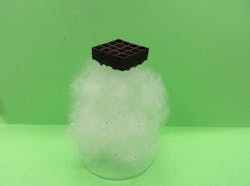University at Buffalo researchers lead 'frozen' synthesis of 3D graphene
Discovered in 2004, graphene is 1 million times thinner than a human hair, 300 times stronger than steel and it's the best known conductor of heat and electricity, making it the next wonder material. These qualities could, among other things, make computers faster, batteries more powerful and solar panels more efficient. Unfortunately, despite the fact that scientists recently poured graphene oxide suspension into freezing molds to create 3D objects with limited commercial applications, graphene is tough to manipulate beyond its 2D form.
RELATED ARTICLE: Graphene photonics are making their way to practical use
Another option is to use a 3D printer. In this scenario, scientists typically mix graphene with a polymer or other thickening agent. This helps keep the structure from falling apart. But when the polymer is removed via thermal process, it damages the delicate structure.
But a research team comprised of engineers from the University at Buffalo (Buffalo, NY), Kansas State University, and the Harbin Institute of Technology in China—may have solved these problems. A study published February 10 in the journal Small describes how the team used a modified 3D printer and frozen water to create lattice-shaped cubes and a three-dimensional truss with overhangs using graphene oxide. The structures could be an important step toward making graphene commercially viable in electronics, medical diagnostic devices, and other industries.
"Graphene is notoriously difficult to manipulate, but the structures we built show that it's possible to control its shape in three-dimensional forms," said Chi Zhou, assistant professor of industrial and systems engineering at UB's School of Engineering and Applied Sciences, and a corresponding author of the study.
Zhou is a member of the Sustainable Manufacturing and Advanced Robotic Technologies (SMART), a UB Community of Excellence launched in 2015; he also is a member of UB's New York State Center of Excellence in Materials Informatics.
In their experiments, the research team mixed the graphene oxide with water. They then printed the lattice framework on a surface of -25°C. The graphene is sandwiched between the layers of frozen ice, which act as a structural support.
After the process is completed, the lattice is dipped in liquid nitrogen, which helps form even stronger hydrogen bonds. The lattice is then placed in a freeze dryer, where the ice is changed into gas and removed. The end result is a complex, 3D structure made of graphene aerogel that retains its shape at room temperature.
"By keeping the graphene in a cold environment, we were able to ensure that it retained the shape we designed. This is an important step toward making graphene a commercially viable material," said Dong Lin, assistant professor of industrial and manufacturing systems engineering at Kansas State University, and the study's other corresponding author.
The researchers plan to build on their findings by investigating how to create aerogel structures formed of multiple materials.
SOURCE: University at Buffalo; http://www.eurekalert.org/pub_releases/2016-03/uab-tst030316.php?
About the Author

Gail Overton
Senior Editor (2004-2020)
Gail has more than 30 years of engineering, marketing, product management, and editorial experience in the photonics and optical communications industry. Before joining the staff at Laser Focus World in 2004, she held many product management and product marketing roles in the fiber-optics industry, most notably at Hughes (El Segundo, CA), GTE Labs (Waltham, MA), Corning (Corning, NY), Photon Kinetics (Beaverton, OR), and Newport Corporation (Irvine, CA). During her marketing career, Gail published articles in WDM Solutions and Sensors magazine and traveled internationally to conduct product and sales training. Gail received her BS degree in physics, with an emphasis in optics, from San Diego State University in San Diego, CA in May 1986.
